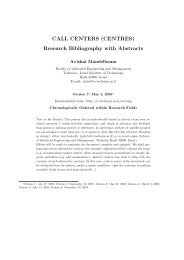A 2 x 2 Game without the Fictitious Play Property - David Levine's ...
A 2 x 2 Game without the Fictitious Play Property - David Levine's ...
A 2 x 2 Game without the Fictitious Play Property - David Levine's ...
Create successful ePaper yourself
Turn your PDF publications into a flip-book with our unique Google optimized e-Paper software.
148 NOTE<br />
As S1 > T1 and ak+1 ≥ ck for every k ≥ 1, (2.2) implies<br />
<br />
<br />
k<br />
T1 + (T2 j+1 − T2 j)<br />
f 2<br />
a (T2k+2) ≥ 1<br />
T2k+2<br />
j=1<br />
As limk→∞(T2k+1/T2k+2) = 1<br />
, we obtain (2.1).<br />
3<br />
3. REMARKS<br />
= f 1<br />
T2k+1<br />
a (T2k+1)<br />
T2k + 2 .<br />
2 × 2 games <strong>without</strong> <strong>the</strong> diagonal property can be easily classified according<br />
to <strong>the</strong> fictitious play property. As this is a degenerate class of games and because<br />
of <strong>the</strong> next remark, we do not think that such a classification is important.<br />
Almost every “natural” tie-breaking rule that is incorporated into <strong>the</strong> definition<br />
of <strong>the</strong> fictitious play process will make Miyasawa’s <strong>the</strong>orem valid; e.g., we can<br />
require that a player never switch from a best-reply strategy to ano<strong>the</strong>r best-reply<br />
strategy, or we can use Miyasawa’s tie breaking rule which, in contrast, assumes<br />
that a player switches to a new best-reply strategy as soon as possible.<br />
REFERENCES<br />
Brown, G. W. (1951). “Iterative Solution of <strong>Game</strong>s by <strong>Fictitious</strong> <strong>Play</strong>,” in Activity Analysis of Production<br />
and Allocation. New York: Wiley.<br />
Deschamps, R. (1973). Ph.D. Thesis. University of Louvain.<br />
Fudenberg, D., and Kreps, D. (1993). “Learning Mixed Equilibria,” <strong>Game</strong>s Econ. Behav. 5, 320–367.<br />
Krishna, V. (1991). “Learning in <strong>Game</strong>s with Strategic Complementarities,” mimeo.<br />
Milgrom, P., and Roberts, J. (1991). “Adaptive and Sophisticated Learning in Normal Form <strong>Game</strong>s,”<br />
<strong>Game</strong>s Econ. Behav. 3, 82–100.<br />
Miyasawa, K. (1961). “On <strong>the</strong> Convergence of <strong>the</strong> Learning Process in a 2 × 2 Non-zero-sum Two<br />
Person <strong>Game</strong>,” Economic Research Program, Princeton University, Research Memorandum No. 33.<br />
Monderer, D., and Shapley, L. S. (1996). “<strong>Fictitious</strong> <strong>Play</strong> <strong>Property</strong> for <strong>Game</strong>s with Identical Interests,”<br />
J. Econ. Theory 1, 258–265.<br />
Robinson, J. (1951). “An Iterative Method of Solving a <strong>Game</strong>,” Ann. Math. 54, 296–301.<br />
Shapley, L. S. (1964). “Some Topics in Two-Person <strong>Game</strong>s,” in Advances in <strong>Game</strong> Theory (M. Dresher,<br />
L. S. Shapley, and A. W. Tucker, Eds.), pp. 1–28. Princeton, NJ: Princeton Univ. Press.
















